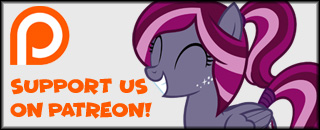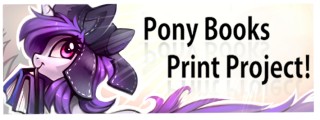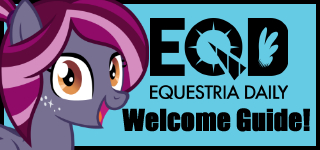Hello and welcome to a new feature premiering this week on Equestria Daily: The Theme Analysis. In it, we'll be diving back into each new episode one more time to start exploring some of the underlying themes and storytelling techniques that these new episodes of Friendship is Magic employ, allowing us to examine the nuts and bolts of our favorite pony tales and together come to a deeper understanding of not only what we like, but why we like it.
To be clear, this is NOT a review, nor is it comprehensive. The thoughts expressed in this article do not reflect the views of Equestria Daily and should not be taken as such. This is also not a recap - Cereal Velocity does a great job going over all the episodes' scenes, jokes, and references, and I'm not here to trod on his hooves.
So if it isn't any of these things, then what is it? At its core, the Theme Analysis is an in depth look at selective scenes from each new Season 3 episode. For each selected scene (or element, in some cases), we'll go over some of the messages, themes, and techniques present, and offer analysis as to what makes these things effective, both in general use and for the specific scene/element discussed.
But with so much to talk about, we can hardly cover everything in this spot. So once you've read it, chime in with your own observations! With all of that said, we have a lot of ground to cover, so let's jump right in!
Celestia's Power Point Presentation: Show and Tell
 |
| In the grimdark future of Equinity, there are only crystals |
Princess Celestia has been this show's dispenser of information since the very beginning, and she's rather good at her job. She understands that prolonged exposure to what might be called "Talking Head Syndrome" will put her audience to sleep. To counteract this, she splices her speech with visible demonstrations - a depiction of the Crystal Empire, the face of King Sombra (and his defeat), and most importantly: her magical display of the effects of love and darkness on the Crystal Empire. It seems very simple, but these few seconds of animation paint a very strong picture of exactly what is at stake for Twilight and company. Not only that, but Celestia's little display of power provides a ready explanation for Twilight Sparkle's later use of the magic, but her demonstration crystal provides a strong visual callback to the crystal atop Sombra's throne. This callback, in turn, lets the audience arrive at the solution before Twilight announces it. By showing while she tells, Celestia helps provide the script with internally consistent logic and boosts the audience's suspension of disbelief. It's a very powerful tool.
Plus, you know, it just looks cool.
I Wasn't Prepared For Crystal Ponies: Song as Narration and Song as Plot Device
 |
| The wind in my hair, the wind in my eyes. Ow! Ow! It's in my eyes! |
In this case, Twilight is expressing her fears and doubts at having to shoulder enormous responsibility in the face of an unknown situation. As sort of a corollary to "Show, Don't Tell", Twilight lets her tone, posture, and music do the bulk of the talking. Her lines shift between old topics she's mastered and the ever looming presence of the task Celestia has given to her, which are accompanied by shifts in the melody and huge, panning shots of Canterlot, making Twilight seem smaller by comparison. The intensity of the situation is impressed upon us through her song.
But why sing in the first place? Even if we accept that the tools used for the song are effective, aren't there other ways to convey that Twilight Sparkle is feeling a touch overwhelmed? In fact, couldn't she just make a frowny face and be done with it? Simply put, while that might save time, it won't leave as large an impact on the audience. Twilight's uncertainty is a major theme that runs through the entirety of the episode(s), and is revisited constantly as the plot progresses. The images, the sounds, and choreography of the Failure Song do a much better job of impressing that upon the audience than other alternatives, while also serving to continue the longstanding relationship between singing and My Little Pony.
 |
| Ewe are (not) alone |
Catchy showtunes: not just for messing around!
King Sombra: Villainous Threats and Narrative Framing
 |
| "Fire and winds come from the sky! But your god is Krom, and he lives in the earth!" |
But the evil unicorn king doesn't fill the same role as his predecessors. Unlike previous two-parters, the primary theme of the episode is not about thwarting or uncovering a villainous plot, but rather Twilight Sparkle wrestling with herself and solving the mysteries of the Crystal Empire. And while Sombra does play a key role in all of that, he does so as a part of its history and, should Twilight fail, its future. Sombra barely speaks, hardly ever crystalizes (ha, see what I did there), because to do so would be contrary to his role in the narrative. Instead, he serves as a looming threat. He cripples Shining Armor and gradually drains Cadance of her power, removing the crutches Twilight has to lean on and forcing her to make faster and more rapid decisions than she is typically comfortable with. He is the darkness, and the threat of failure, and both of these things are infinitely less threatening when they're given form.
By pulling attention away from the newest villain, the episode is able to use him as a super intense magnifying glass to hover over our protagonist and provide a genuine sense of urgency to everything she does. That urgency in turn drives the story forward. You can certainly shine a bigger spotlight on him, but then it becomes a very different story.
The Door to Darkness: Characterization Through Staging
 |
| "Learn that you are my puppet!" |
As we watch Twilight gleefully enchanting the crystals in his throne room with dark magics to open a path, we're also treated to very distinctive visual effects - a roiling, bubbling aura that hints at the corruptive power of the shadows. And then we come to the door down below, which moves and shifts for those without magical power, and opens up to nothing but nightmares for anyone who would dare use Sombra's power against him. And so we can see that he is also viciously cruel, a fact further highlighted by the crystal ponies' refusal to talk about life under his rule. These effects are subtle, but together paint a much more cohesive picture of the unicorn than one might initially think exists.
But that door has a lot more to teach us about characterization and dramatic structure. As Twilight faces it, fresh from her earlier triumph by way of icky shadow magic, she quickly turns back to that source as an obvious solution to her problem. And at first she seems to be rewarded for it, only for it to be revealed that the door literally leads nowhere but the darkest corners of her heart (and also a rock wall). As Spike comes to her rescue only to be faced with his own worst fears, we're confronted with what may be the most poignant scene outlining the relationship between these two characters to date. Moreover, Twilight has been taught a very valuable lesson which acts as an undercurrent for the entire story and its accompanying themes - that only by staying true to herself and avoiding bad influences will she gain the prize she seeks. Moments later when she's faced with her fear of failure in a much more literal sense, she applies this lesson and further highlights this dynamic.
Man, who would've thought there'd be so much squeezed into a single minute of a pony cartoon?
Sometimes, You've Gotta Throw Your Wife: A Use For Every Character
 |
| Couple's Therapy Gone Wrong |
Of course, this episode takes this lesson to heart, and keeps very careful track of the abilities and presence of the characters it makes use of. Shining Armor, a master of protection spells, is quickly put out of commission by Sombra's curse. This leaves Cadance as the only one capable of buying time. Twilight's friends, of course, are there to lend support (in broader terms, they're also there to provide comic relief and keep the tone of the story within the acceptable parameters of an MLP episode) and help keep the crystal ponies in high enough spirits to get their jobs done.
But if Shining Armor is only there to be nullified, this creates a very weak dynamic. The question immediately shifts to what he's doing there in the first place. Maybe some other character could have facilitated his role as a friendly face for Twilight to bounce ideas off of and attend to Cadance. The answer to that is very nicely encapsulated in the image you see above you. Yes, it's a very silly scene, but it's also a powerful reinforcement of the messages running through the episode to this point: Twilight's need to seek help from others despite being tasked to "handle it alone". A pony (and Twilight's family at that) stepping outside their comfort zone/specialty to get the job done. And like many things in FiM, it's a little touch of fun that keeps everything feeling fresh and unique even while it leans heavily on a number of tropes.
Without Shining Armor, this episode would have struggled to carry its themes and messages as strongly. Not bad for a minor character with horn rot!
Letters to Celestia: The Final Thoughts
 |
| Yes, Celestia. I was disappointed by the lack of Lyra, too. |
The Season 3 premier is what I would refer to as a "world building" episode. The primary purpose is to expand on our understanding of Equestria and its borders, denizens, and history. By painting with broad strokes, it accomplishes this and sets a foundation for a large number of stories to come. Will we see more of the Crystal Empire? Ultimately, it doesn't matter. We've already learned huge amounts about the way the setting works. We've established new ways for the powers of love and harmony to be used to power magic outside the Elements of Harmony, while at the same time reinforcing the things we knew about characters old and new.
Friendship is Magic has always been about building something greater than the sum of its parts, and as those parts grow in number, the potential for the series continues to grow. Season 3 looks to be heading in very new and different directions from its earlier roots, and only time will show us exactly where that is. Of course, when it does come to light, we'll be here to dive in deeper and poke at all the little things that makes it tick.
So I guess what I'm saying is, fanfic writers? Get to work.






































